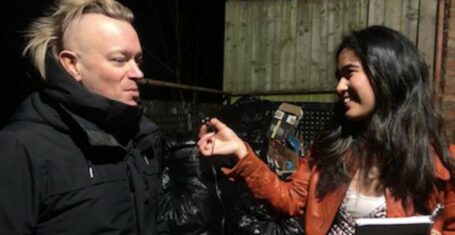
REVIEWED: The Crucible
A didactic classic done well – highly entertaining.
 The Crucible is a classic. A classic which I had never had never had the chance to watch in performance, despite being a great fan of Miller. Entering the space, I had my reservations. Miller’s ‘girls dancing in the woods’ were in tableaux around the space, with leaves scattered on the floor and a hypnotic drumbeat being heard from the front of the stage. And yet, the heightened realism of the movement piece that followed, led by Lily Morgan as Tituba, was surprisingly effective – as was the rest of the production.
The Crucible is a classic. A classic which I had never had never had the chance to watch in performance, despite being a great fan of Miller. Entering the space, I had my reservations. Miller’s ‘girls dancing in the woods’ were in tableaux around the space, with leaves scattered on the floor and a hypnotic drumbeat being heard from the front of the stage. And yet, the heightened realism of the movement piece that followed, led by Lily Morgan as Tituba, was surprisingly effective – as was the rest of the production.
The stage curtain was pulled back to reveal a somewhat drab and disappointing first set. This was only to improve however, as the following three painted cycloramas were detailed enough without being distracting and allowed for much greater stage space which the director, Rachel Nwokoro, used well. The period costuming too was very appropriate. Lighting was, for the most part, very effective though there were one or two lighting fast changes that seemed awkwardly incongruous with the onstage action.
For such a long production Nwokoro paid good attention to detail. From the offstage singing during transitions, cyclical repetition of the hypnotic drumbeat towards the end of the piece and sudden onstage silences to some lovely cinematic stage pictures. What didn’t work at all were moments of onstage violence – particularly the stage slaps – which looked amateurish in performance, and often, ruined the tension of the scene.
What I loved about watching this during its second performance was the sheer lack of opening night nerves and/or gaffes, although it must be said that some moments of dialogue were rushed somewhat. Nevertheless, generally, the cast gave an aura of confidence, and so were not restricted by having to focus too heavily on what the correct script / choreography was. Rather, at times, they were able to play with their characters, to bring them to life in interesting ways. They may have all had such moments of brilliance but it was not necessarily consistent throughout. Generally the cast had a good energy though the end was definitely stronger than the beginning – with the suspense of the impending hangings, the cast picked up their game. Although almost all cast members had their shaky moments, it was the courtroom scene in which they all flourished.
William Rhodes took time to relax into his role during the first act and the performance ended with nobody in doubt that he was stunning in his portrayal as John Proctor. The final scene, with his character alongside Sophia Harrop’s skilled portrayal of Elizabeth Proctor, was very tender and poignant. The two talented actors really had the audience in the palm of their hand. William Hannam, Michael McLauchlan and Jordan Millican, with booming voices, made for a formidable trio (as the court). Their simple breaking of the fourth wall was an inspired directorial choice, that contributed much to the meaning of the play. Anna Feroldi performed a truly conniving Abigail and Chloe Fagan played up the vulnerability in Mary Warren well, whilst Joe Skelton’s authoritative Ezekiel Cheever had great depth. Lucy Oliver, Rory Barnes and Beatrice Vincent, as Ann Putnam, Reverend Hale and Rebecca Nurse respectively, had immediate stage presence whilst Hannah Samano, as Mercy Lewis, displayed some excellent comic timing.
This was an incredibly effective production, with clearly a dedicated production team and talented cast. All allusion to McCarthyism was certainly kept implicit, and demanded the audience had somewhat of a prior knowledge of the play, if they were to make the link. This however, in my mind, did not matter. The audience were entertained for over three hours, and upon leaving the hall, all seemed to be chatting about the rights and wrongs of the didactic plot.
Photographs credit to Rachel Nworkoro.









































